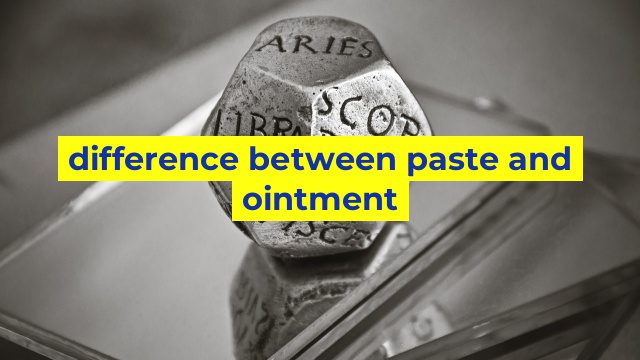The Difference Between Paste and Ointment: Which One Should You Use?
When it comes to treating skin ailments, there’s no shortage of options on the market. Two popular choices are pastes and ointments, but how do you know which one to choose? In this article, we’ll explore the differences between paste and ointment, so you can make an informed decision.
What is Paste?
Paste is a thick, sticky substance that is used to treat a variety of skin conditions, such as eczema, psoriasis, and rashes. It is usually made from a combination of oils, waxes, and powders, which work together to create a barrier on the skin. Because paste is so thick, it stays in place for longer periods of time than other treatment options.
One of the most significant benefits of paste is that it is non-greasy, making it ideal for use on the face and other sensitive areas. It is also less likely to stain clothing, which is a crucial consideration for many people.
What is Ointment?
Like paste, ointment is a topical treatment that is used to address a range of skin conditions. It is made from a combination of oils and waxes, which help to lock in moisture and protect the skin’s natural barrier.
Unlike paste, ointment has a greasy texture, which can make it messy and difficult to use. However, because it is so hydrating, it is an excellent option for use on dry and cracked skin.
When to Use Paste vs. Ointment
Deciding which treatment to use depends on the specific condition you are trying to address. If you need a treatment that won’t leave residue or stain your clothes, paste is an excellent option. It is also better for use on the face and other sensitive areas of the body.
If you are dealing with dry, cracked skin, ointment is the better choice. Its greasy texture helps to lock in moisture and can provide relief from the discomfort associated with dry skin.
The Bottom Line
Ultimately, the decision between paste and ointment comes down to personal preference and the condition you are trying to treat. While both options are effective at addressing a wide range of skin ailments, paste is a better choice for those who need a non-greasy solution, whereas ointment is ideal for those dealing with dry, cracked skin. Consult with your dermatologist to determine which option is best for you.
Table difference between paste and ointment
| Paste | Ointment | |
|---|---|---|
| Definition | A semi-solid substance that is thicker than ointment | A semi-solid substance that is greasy and smooth in consistency |
| Appearance | Opaque and thick | Semi-clear and greasy |
| Texture | Gritty and thick | Smooth and greasy |
| Usage | Used for skin conditions such as diaper rash, and fungal infections | Used for skin conditions such as eczema, psoriasis, and dry skin |
| Absorption | Takes longer to absorb into skin | Quickly absorbs into skin |

